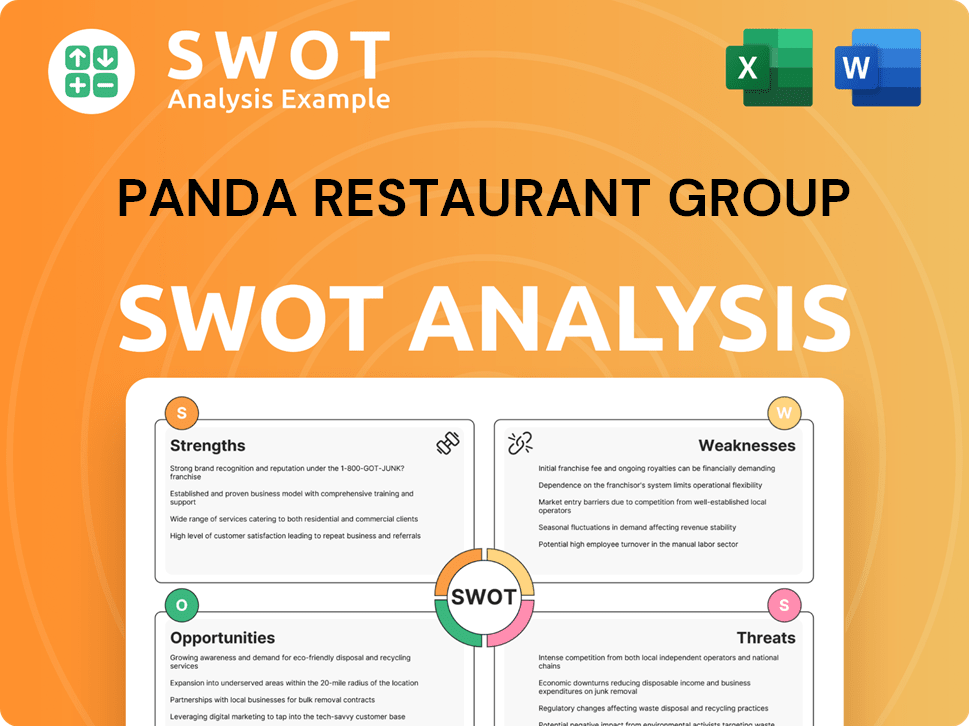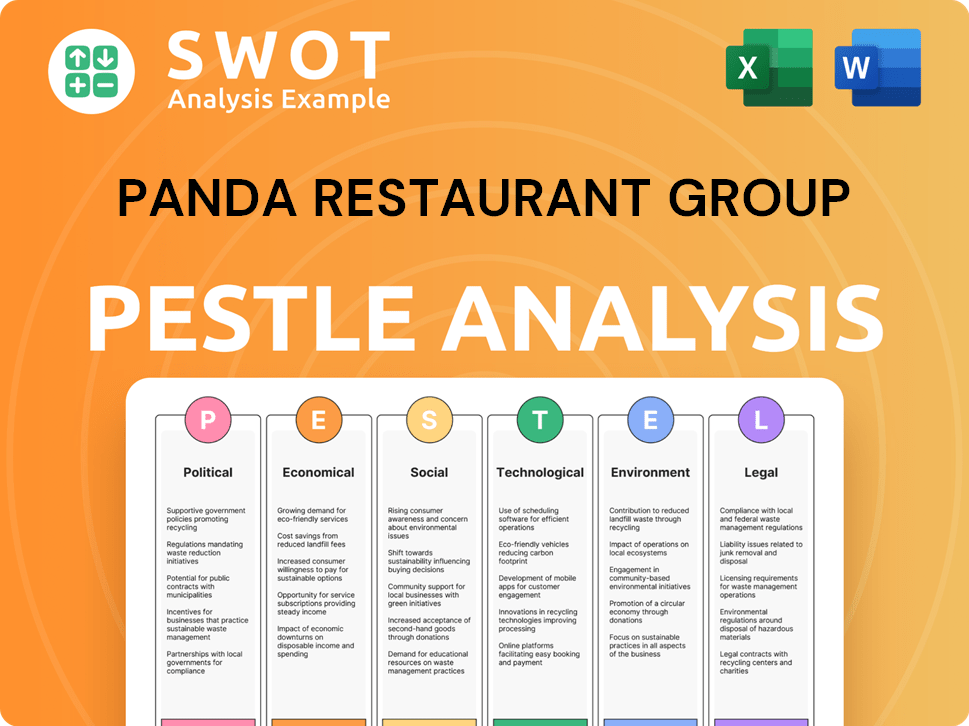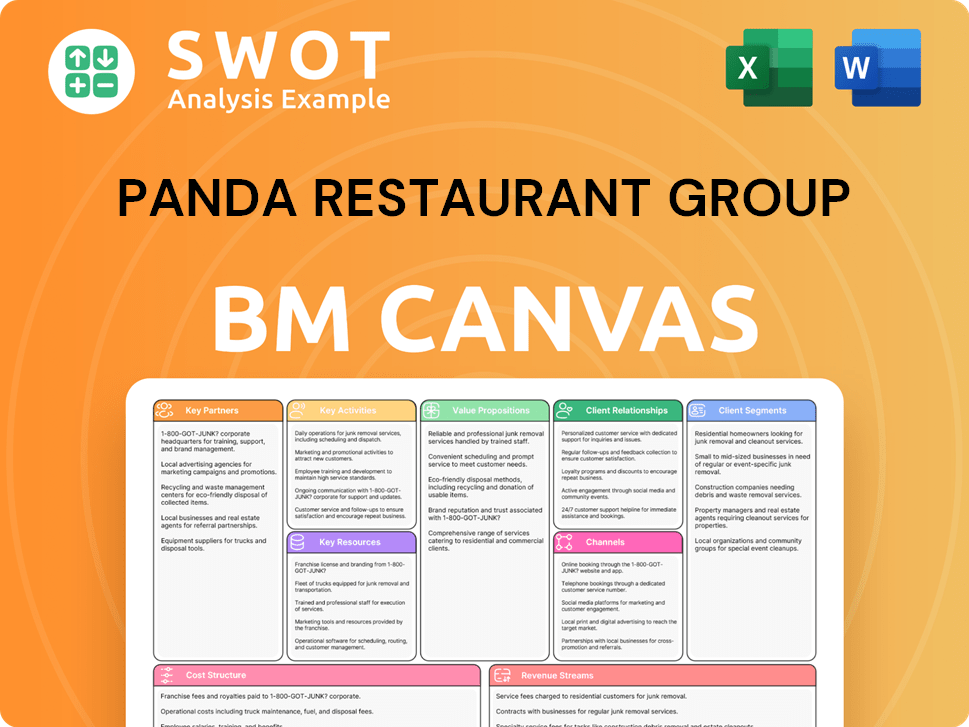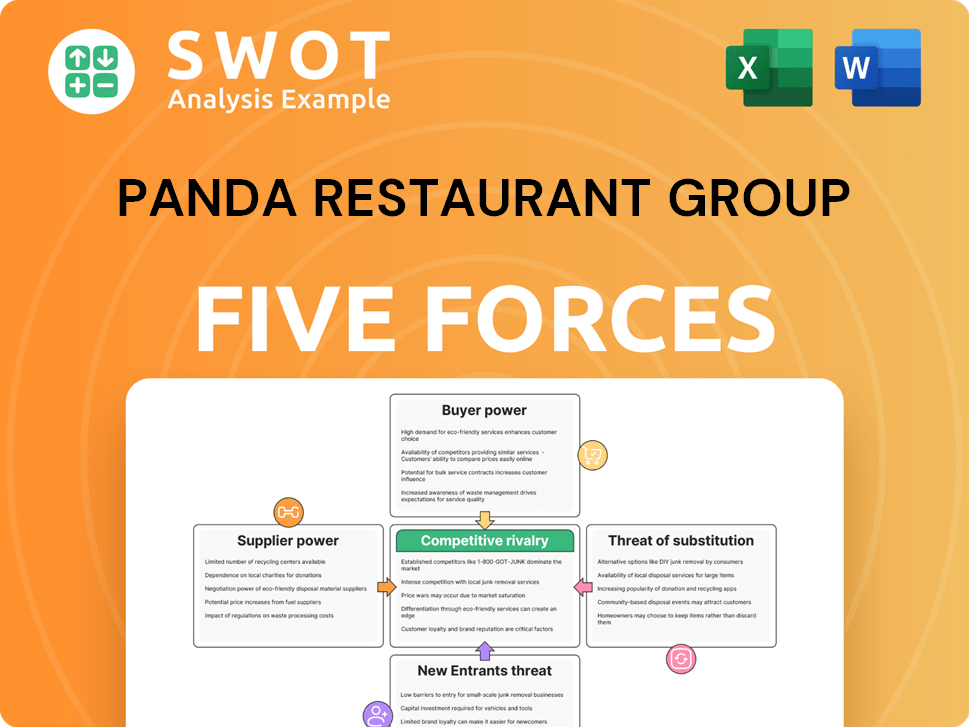Panda Restaurant Group Bundle
Can Panda Restaurant Group Maintain Its Dominance?
Panda Restaurant Group, the powerhouse behind Panda Express, has carved a significant niche in the American fast-casual dining scene. From its humble beginnings in 1973, the company has transformed into a giant within the Asian-segment restaurant sector, captivating millions with its unique take on American Chinese cuisine. But in a fiercely contested market, how does Panda Restaurant Group navigate its Panda Restaurant Group SWOT Analysis and what strategies are in place to maintain its competitive edge?

This exploration of the Panda Restaurant Group's competitive landscape will provide a comprehensive market analysis, identifying key competitors and analyzing industry trends. Understanding the competitive advantages of Panda Express and its expansion strategy is crucial. We'll delve into the challenges faced by Panda Restaurant Group, its financial performance, and how it aims to stay ahead in the evolving restaurant industry, offering insights for investors and industry observers alike. This analysis will also answer questions such as "Who are Panda Express's main rivals?" and how Panda Express competes in the fast-food chain market.
Where Does Panda Restaurant Group’ Stand in the Current Market?
Panda Restaurant Group, primarily through its Panda Express brand, holds a strong market position in the U.S. Asian-segment restaurant industry. Panda Express is recognized as the largest Asian fast-casual restaurant chain in the United States, demonstrating its widespread presence and brand recognition. This leadership is a key aspect of its competitive landscape.
The company's core operations revolve around American Chinese cuisine, offering a diverse menu that includes popular entrees like Orange Chicken and Kung Pao Chicken. These offerings, along with sides such as chow mein and fried rice, cater to a broad customer base seeking convenient and flavorful Asian-inspired meals. Panda Express has strategically expanded its presence over time, adapting to consumer demands.
While specific market share figures for 2024-2025 are not readily available in the public domain, Panda Express consistently ranks as a top performer in terms of sales and unit count within its segment. The company's focus on providing a consistent and appealing dining experience has contributed to its sustained success. To understand more about its origins, you can read a Brief History of Panda Restaurant Group.
Panda Express boasts a significant footprint across the United States. With over 2,500 locations, including those in airports, universities, and other non-traditional venues, the company has established a wide reach. This extensive network allows Panda Express to serve a large customer base and maintain its competitive edge.
The primary target market for Panda Express consists of a broad customer segment. These customers are seeking convenient, affordable, and flavorful Asian-inspired meals. Panda Express caters to individuals and families looking for a quick and satisfying dining experience.
Panda Express has explored digital transformation initiatives. These efforts aim to enhance the customer experience and improve operational efficiency. Digital initiatives include online ordering, mobile apps, and loyalty programs, which are crucial for adapting to evolving consumer preferences and maintaining a competitive position within the restaurant industry.
The menu primarily focuses on American Chinese cuisine. Popular items like Orange Chicken, Beijing Beef, and Kung Pao Chicken are central to its offerings. The menu also includes sides such as chow mein and fried rice. The menu's variety and appeal are critical to attracting and retaining customers.
Panda Express's success is rooted in several key advantages within the restaurant industry. These include its strong brand recognition, extensive geographic presence, and consistent focus on quality and convenience.
- Brand Recognition: Panda Express is a well-known and trusted brand.
- Convenience: The fast-casual model and widespread locations enhance convenience.
- Menu Appeal: The diverse and popular menu offerings attract a broad customer base.
- Operational Efficiency: Digital initiatives and streamlined operations improve efficiency.
Panda Restaurant Group SWOT Analysis
- Complete SWOT Breakdown
- Fully Customizable
- Editable in Excel & Word
- Professional Formatting
- Investor-Ready Format

Who Are the Main Competitors Challenging Panda Restaurant Group?
The Panda Restaurant Group, particularly through its flagship brand Panda Express, operates within a dynamic and fiercely competitive landscape. A thorough market analysis reveals that the company faces challenges from various angles, requiring strategic adaptability to maintain its market position. Understanding the competitive landscape is crucial for Panda Express to formulate effective strategies and ensure sustained growth.
The restaurant industry is constantly evolving, influenced by industry trends such as changing consumer preferences, technological advancements, and economic conditions. The Panda Restaurant Group must navigate these factors to remain competitive. The company's success depends on its ability to identify and respond to competitive pressures effectively.
Panda Express competes with a range of players, both directly and indirectly. The company's ability to differentiate itself and maintain a strong brand presence is key to its success. Understanding the strengths and weaknesses of its competitors is essential for strategic planning.
These include smaller regional chains and independent Chinese restaurants. They often offer similar American Chinese cuisine.
Panda Express competes with fast-casual restaurants like Chipotle Mexican Grill and Subway. These chains offer customizable meals and quick service.
Burger chains like McDonald's and Burger King, and chicken-focused establishments such as Chick-fil-A, are also competitors. These restaurants compete for the same consumer dollars and dining occasions.
Platforms like DoorDash and Uber Eats broaden the reach of many restaurants, increasing competition. These platforms impact the competitive environment.
New restaurants focusing on niche Asian cuisines or digital-first models pose a potential disruption. These players can impact the Panda Restaurant Group's market share.
The increasing popularity of various ethnic cuisines adds to the competitive pressures. Consumers have more choices than ever.
To maintain a competitive edge, Panda Express must continually analyze its position. The strategies discussed in the Marketing Strategy of Panda Restaurant Group article highlight the importance of a strong marketing approach. Understanding the competitive advantages of Panda Express and addressing the challenges faced by Panda Restaurant Group are critical for long-term success. The Panda Express expansion strategy must consider these factors to ensure continued growth. A thorough Panda Express SWOT analysis can help identify strengths, weaknesses, opportunities, and threats. The Panda Restaurant Group business model must adapt to the changing dynamics of the restaurant industry.
Panda Express competes on various factors, including menu offerings, pricing, convenience, and brand reputation. The company's ability to adapt to consumer preferences is key. Understanding the Panda Express target market is crucial for effective competition.
- Menu Innovation: Continuously updating and innovating the menu to appeal to a broad customer base.
- Pricing Strategies: Offering competitive pricing and value-driven meal options.
- Convenience: Providing convenient locations, drive-thru services, and online ordering.
- Brand Building: Maintaining a strong brand reputation and positive customer experiences.
- Digital Presence: Leveraging online platforms and delivery services to increase accessibility.
Panda Restaurant Group PESTLE Analysis
- Covers All 6 PESTLE Categories
- No Research Needed – Save Hours of Work
- Built by Experts, Trusted by Consultants
- Instant Download, Ready to Use
- 100% Editable, Fully Customizable

What Gives Panda Restaurant Group a Competitive Edge Over Its Rivals?
The competitive advantages of the Panda Restaurant Group are built on operational efficiency, strong brand recognition, and strategic market positioning. These elements work together to create a robust and sustainable business model within the competitive restaurant industry. A deep dive into these areas reveals the key factors that contribute to the company's success and resilience.
One of the primary strengths of the Panda Restaurant Group lies in its highly efficient operational model. This efficiency allows for consistent quality and quick service across its extensive network of locations. The company's ability to maintain high standards while serving a large customer base is a significant advantage, especially in the fast-paced restaurant industry. This operational excellence is supported by a robust supply chain, ensuring the availability of fresh ingredients and standardized preparation methods.
Another key advantage is the strong brand equity that Panda Express has cultivated over the years. This strong brand presence reduces marketing costs and fosters repeat business. The company also benefits from economies of scale, allowing it to negotiate favorable terms with suppliers and optimize its cost structure, which can be challenging for smaller competitors to match. Furthermore, Panda Express has demonstrated adaptability by integrating technology into its operations, including online ordering and delivery services, which enhances customer convenience and broadens its reach.
The company's operational model ensures consistent quality and quick service. This efficiency is critical in maintaining customer satisfaction and managing costs. A key aspect is the robust supply chain that ensures fresh ingredients and standardized preparation methods.
Panda Express enjoys strong brand recognition and customer loyalty. This reduces marketing costs and drives repeat business. The signature Orange Chicken is a key driver of this brand recognition.
The company leverages its size to negotiate favorable terms with suppliers. This allows for cost optimization, a significant advantage over smaller competitors. These efficiencies contribute to higher profit margins.
Integration of technology, such as online ordering and delivery, enhances customer convenience. This adaptability helps in broadening the company's reach and meeting evolving consumer preferences. This is a key element of the Growth Strategy of Panda Restaurant Group.
The Panda Restaurant Group's competitive advantages are multifaceted, contributing to its strong market position. These advantages are relatively sustainable due to the company's scale and established infrastructure, though they face threats from aggressive pricing strategies by rivals and evolving consumer preferences. Understanding these advantages is essential for a thorough market analysis within the restaurant industry.
- Operational efficiency ensures consistent quality and quick service.
- Strong brand equity, including recognition of the Orange Chicken, drives customer loyalty.
- Economies of scale allow for favorable supplier terms and cost optimization.
- Adaptability through technology enhances customer convenience and reach.
Panda Restaurant Group Business Model Canvas
- Complete 9-Block Business Model Canvas
- Effortlessly Communicate Your Business Strategy
- Investor-Ready BMC Format
- 100% Editable and Customizable
- Clear and Structured Layout

What Industry Trends Are Reshaping Panda Restaurant Group’s Competitive Landscape?
Analyzing the Panda Restaurant Group's competitive landscape involves understanding the restaurant industry's current state and future trajectory. The company, known for its Panda Express chain, navigates a complex market influenced by various factors. This market analysis considers industry trends, potential challenges, and emerging opportunities that could impact the company's performance and strategic direction.
The competitive environment for Panda Restaurant Group is dynamic, shaped by shifts in consumer preferences, technological advancements, and economic conditions. Understanding these elements is crucial for assessing the company's position and prospects within the restaurant industry. This analysis will explore the key factors that influence Panda Express's ability to maintain and grow its market share.
The restaurant industry is experiencing significant changes. Digital ordering and delivery services are becoming increasingly important, as are health-conscious eating habits. Sustainability and transparency in sourcing are also gaining importance. These trends are reshaping the competitive landscape.
Panda Restaurant Group faces challenges like rising labor costs and supply chain disruptions. Competition from fast-casual restaurants and changing consumer preferences also pose threats. Adapting to these challenges is essential for continued success.
Expanding into new markets and innovating with menu options present opportunities for growth. Investing in digital transformation and forming strategic partnerships can also boost customer engagement and operational efficiency. These are crucial for future expansion.
Panda Express needs to adapt to changing consumer demands and leverage technology. Focusing on innovation, operational efficiency, and brand appeal is essential. These strategies can help maintain a strong competitive position.
Panda Restaurant Group's future success depends on several factors. These include adapting to evolving consumer preferences, leveraging technology, and managing operational costs effectively. Strategic decisions will shape the company's ability to thrive in a competitive market.
- Focus on menu innovation to meet changing tastes.
- Invest in digital platforms for online ordering and customer engagement.
- Explore international expansion opportunities.
- Manage supply chain risks and labor costs.
Panda Restaurant Group Porter's Five Forces Analysis
- Covers All 5 Competitive Forces in Detail
- Structured for Consultants, Students, and Founders
- 100% Editable in Microsoft Word & Excel
- Instant Digital Download – Use Immediately
- Compatible with Mac & PC – Fully Unlocked

Related Blogs
- What are Mission Vision & Core Values of Panda Restaurant Group Company?
- What is Growth Strategy and Future Prospects of Panda Restaurant Group Company?
- How Does Panda Restaurant Group Company Work?
- What is Sales and Marketing Strategy of Panda Restaurant Group Company?
- What is Brief History of Panda Restaurant Group Company?
- Who Owns Panda Restaurant Group Company?
- What is Customer Demographics and Target Market of Panda Restaurant Group Company?
Disclaimer
All information, articles, and product details provided on this website are for general informational and educational purposes only. We do not claim any ownership over, nor do we intend to infringe upon, any trademarks, copyrights, logos, brand names, or other intellectual property mentioned or depicted on this site. Such intellectual property remains the property of its respective owners, and any references here are made solely for identification or informational purposes, without implying any affiliation, endorsement, or partnership.
We make no representations or warranties, express or implied, regarding the accuracy, completeness, or suitability of any content or products presented. Nothing on this website should be construed as legal, tax, investment, financial, medical, or other professional advice. In addition, no part of this site—including articles or product references—constitutes a solicitation, recommendation, endorsement, advertisement, or offer to buy or sell any securities, franchises, or other financial instruments, particularly in jurisdictions where such activity would be unlawful.
All content is of a general nature and may not address the specific circumstances of any individual or entity. It is not a substitute for professional advice or services. Any actions you take based on the information provided here are strictly at your own risk. You accept full responsibility for any decisions or outcomes arising from your use of this website and agree to release us from any liability in connection with your use of, or reliance upon, the content or products found herein.